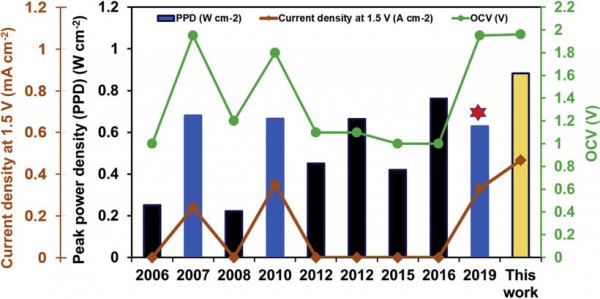According to foreign media reports, the United States is one of the world's largest energy consumers, and the electrification of the transportation sector is vital to the future energy and environment. However, the electrification of this sector requires high-power fuel cells (used alone or in combination with batteries) to facilitate the transition to electric vehicles (cars and trucks), ships and aircraft.

(Image source: University of Washington)
Liquid fuel cells are a perfect alternative to traditional hydrogen fuel cells because they do not need to transport and store hydrogen, and can provide power for unmanned submersibles, unmanned aerial vehicles and electric aircrafts, and can greatly reduce costs. In addition, this type of fuel cell can also be used as a range extender for existing pure electric vehicles to promote the popularization of electric vehicles.
Now, engineers at the McKelvey School of Engineering at Washington University in St. Louis in the United States have developed a high-power direct borohydride fuel cell (DBFC) whose working voltage is twice that of traditional hydrogen fuel cells.
The research team, led by Vijay Ramani, a distinguished university professor of Roma B. and Raymond H. Wittcoff, took the lead in developing a reactant: the optimal flow rate, flow field structure and residence time for high-power operation can be determined, thereby solving the problem of DBFC The key challenge is proper distribution of fuel and oxidizer and mitigation of parasitic reactions.
More importantly, the team demonstrated a single cell with an operating voltage of 1.4V or higher, twice that of a conventional hydrogen fuel cell, and a peak power close to 1 watt/cm². Double the voltage to achieve a smaller, lighter, and more efficient fuel cell design, which means that when multiple cells are turned into battery packs for commercial use, significant advantages in weight and volume will be obtained. In addition, the researchers' method is also widely applicable to other types of liquid fuel cells.
The key to improving the existing fuel cell technology is to reduce or eliminate side effects. The main research direction to achieve this goal includes the development of new catalysts to solve the major obstacles faced by the use of fuel cells and on-site deployment of fuel cells.
The researchers said: "Fuel cell manufacturers are usually unwilling to invest a lot of money or energy to adopt a new material, but using existing hardware and components to achieve the same or better performance can change the rules of the game. Hydrogen foam is formed on the catalyst surface. It has always been a problem with direct sodium borohydride fuel cells, but the impact of this problem can be minimized by rational design of the flow field.†(Yu Qiuyun)
Cationic Dyes,Basic Red 14,Basic Yellow 28,Cationic Blue Sd-Bl
ZHEJIANG E-DYE SUPPLY CHAIN MANAGEMENT CO.,LTD. , https://www.easytodyes.com